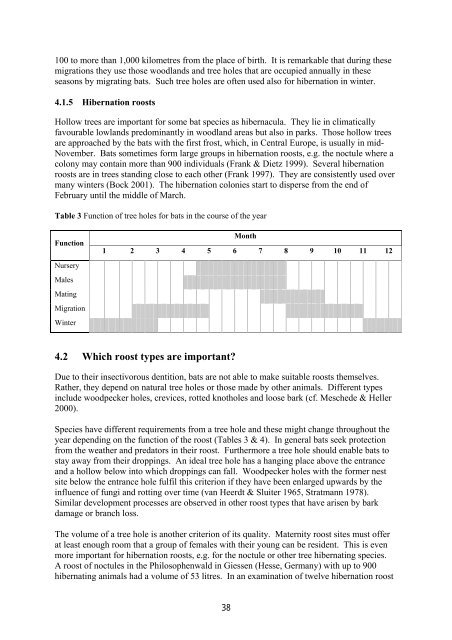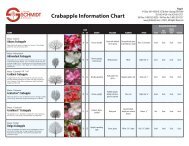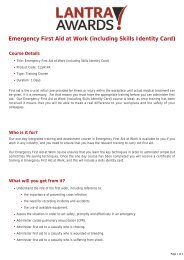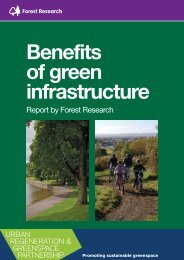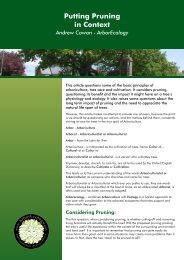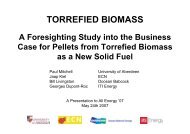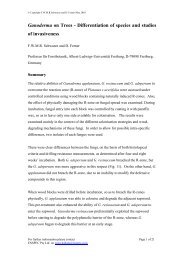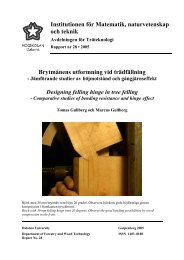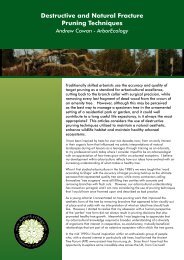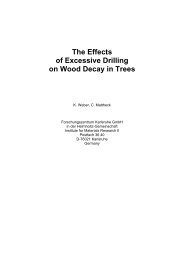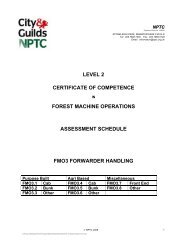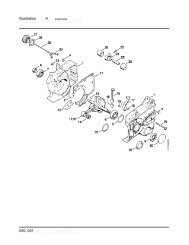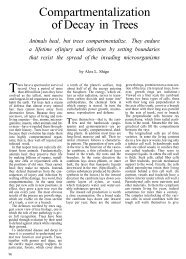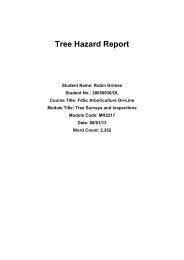100 to more than 1,000 kilometres from the place of birth. It is remarkable that during thesemigrations they use those woodlands and tree holes that are occupied annually in theseseasons by migrating bats. Such tree holes are often used also <strong>for</strong> hibernation in winter.4.1.5 Hibernation roostsHollow trees are important <strong>for</strong> some bat species as hibernacula. They lie in climaticallyfavourable lowlands predominantly in woodland areas but also in parks. Those hollow treesare approached by the bats with the first frost, which, in Central Europe, is usually in mid-November. Bats sometimes <strong>for</strong>m large groups in hibernation roosts, e.g. the noctule where acolony may contain more than 900 individuals (Frank & Dietz 1999). Several hibernationroosts are in trees standing close to each other (Frank 1997). They are consistently used overmany winters (Bock 2001). The hibernation colonies start to disperse from the end ofFebruary until the middle of March.Table 3 Function of tree holes <strong>for</strong> bats in the course of the yearFunctionMonth1 2 3 4 5 6 7 8 9 10 11 12NurseryMalesMatingMigrationWinter4.2 Which roost types are important?Due to their insectivorous dentition, bats are not able to make suitable roosts themselves.Rather, they depend on natural tree holes or those made by other animals. Different typesinclude woodpecker holes, crevices, rotted knotholes and loose bark (cf. Meschede & Heller2000).Species have different requirements from a tree hole and these might change throughout theyear depending on the function of the roost (Tables 3 & 4). In general bats seek protectionfrom the weather and predators in their roost. Furthermore a tree hole should enable bats tostay away from their droppings. An ideal tree hole has a hanging place above the entranceand a hollow below into which droppings can fall. Woodpecker holes with the <strong>for</strong>mer nestsite below the entrance hole fulfil this criterion if they have been enlarged upwards by theinfluence of fungi and rotting over time (van Heerdt & Sluiter 1965, Stratmann 1978).Similar development processes are observed in other roost types that have arisen by barkdamage or branch loss.The volume of a tree hole is another criterion of its quality. Maternity roost sites must offerat least enough room that a group of females with their young can be resident. This is evenmore important <strong>for</strong> hibernation roosts, e.g. <strong>for</strong> the noctule or other tree hibernating species.A roost of noctules in the Philosophenwald in Giessen (Hesse, Germany) with up to 900hibernating animals had a volume of 53 litres. In an examination of twelve hibernation roost38
sites it was found that the possibility of <strong>for</strong>ming large groups was of greater importance thanthe thickness of the tree (Dietz & Frank personal observation).When reviewing the literature about tree-dwelling bat species it becomes clear thatwoodpecker holes play an important role <strong>for</strong> almost all bat species. These are primarily theholes of the great spotted woodpecker, middle spotted woodpecker, grey-headed, and greenwoodpecker (Picoides and Picus species). Holes of the black woodpecker are not oftenoccupied, possibly because of the big entrance and the danger of predation by martens.Crevices in the trunk or in strong side branches are also very frequently used, if they provideenough hollow room and hiding places above the entrance. Which of these two roost types ispreferred can be different in one species, depending on the area (cf. Daubenton’s bat: Nyholm1965, Geiger 1992, Dietz 1993, Rieger 1996). Initially it is presumably dependent on theavailability of structures in a region but the imprinting phase of the young could also play animportant role <strong>for</strong> habitat preference and roost selection, a feature typical of mammals.Roosting under loose bark is characteristic of the barbastelle (Steinhauser 2002, personalobservations), and sometimes also <strong>for</strong> Brandt’s or whiskered bats and Nathusius’ pipistrelles.Table 4 Tree hole types used by batsSpecieswoodpeckerholeRoost typecrevicesboughdamageBehindloose barkRhinolophus ferrumequinumRhinolophus hipposiderosMyotis daubentonii ● ● ○Myotis bechsteinii ● ○ ○Myotis nattereri ● ●Myotis mystacinus ○ ●Myotis brandtii ● ●Pipistrellus pipistrellus ○ ○Pipistrellus pygmaeus ? ?Pipistrellus nathusii ● ● ○ ●Eptesicus serotinus ○ ○Nyctalus noctula ● ● ○Nyctalus leisleri ● ● ○ ○Plecotus auritus ● ●Plecotus austriacusBarbastella barbastellus ○ ●[personal observation on Bechstein’s bat, Daubenton’s bat, Natterer’s bat, whiskered bat,Brandt’s bat, noctule, Leisler’s bat, brown long-eared bat and barbastelle; furthermore:Bechstein’s bat (Bayerl 2004), Daubenton’s bat (Rieger 1996), Natterer’s bat (Siemers andothers 1999), whiskered bat (Taake 1984, Godman 1995), Brandt’s bat (Dense & Rahmel2002), common pipistrelle (Taake & Vierhaus 2004), Nathusius’ pipistrelle (Schorcht andothers 2002, Vierhaus 2004), noctule (Gaisler 1979, Frank 1997), Leisler’s bat (Schorcht2002), brown long-eared bat (Fuhrmann & Seitz 1992) and barbastelle (Steinhauser 2002)]39
- Page 3: English Nature Research ReportsNumb
- Page 7 and 8: ContentsPreamble1. Legal aspects...
- Page 9 and 10: 1. Legal aspectsThere are three int
- Page 11 and 12: to the Agreement decided that the c
- Page 13 and 14: Country European Community EUROBATS
- Page 15 and 16: types in Europe where many of the e
- Page 17 and 18: • the European Commission initiat
- Page 19 and 20: Foraging areas: Central European sp
- Page 21 and 22: Other roosts: In foraging areas and
- Page 23 and 24: Brandt’s bat travels up to 250 ki
- Page 25 and 26: others 2004). Maternity colonies al
- Page 27 and 28: 1995, The Netherlands: Limpens and
- Page 29 and 30: from a maternity colony covered a t
- Page 31 and 32: hibernaculum is the Levensau Bridge
- Page 33 and 34: female (Fuhrmann and others 2002).
- Page 35 and 36: Foraging areas: In Central Europe f
- Page 37: Table 2 Importance of tree holes fo
- Page 41 and 42: advancing age of a tree its potenti
- Page 43 and 44: floor up to the canopy and beyond c
- Page 45 and 46: Table 6 Overview of the most freque
- Page 47 and 48: 6.2 2nd step: Active search for roo
- Page 49 and 50: This first approach to a woodland b
- Page 51 and 52: number of tree-dwelling birds in pr
- Page 53 and 54: Types of boxes used by batsThere ar
- Page 55 and 56: oxes exposed to the sun. As an exam
- Page 57 and 58: Con: Bats use bat boxes selectively
- Page 59 and 60: 9. ReferencesABULADZE, A., BUXNIKAS
- Page 61 and 62: BEKKER, J.P. 1990. Ervaringen met v
- Page 63 and 64: BRAUN, M., & HÄUSSLER, U. 2003c. K
- Page 65 and 66: Ökologie und Verbreitung von Arten
- Page 67 and 68: (Germany). In: PRIEDE, I. G. & SWIF
- Page 69 and 70: (Nyctalus leisleri) sowie zur Besie
- Page 71 and 72: HEISE, G. 1985. Zu Vorkommen, Phän
- Page 73 and 74: JONES, G. 1990. Prey selection by t
- Page 75 and 76: (Chiroptera: Vespertilionidae). - P
- Page 77 and 78: Ökologie und Verbreitung von Arten
- Page 79 and 80: PÉREZ, J. L. & IBÁÑEZ, C. 1991.
- Page 81 and 82: ROTTMANN, R., BOYE, P. & MEINIG, H.
- Page 83 and 84: SCHORCHT, W., and others. 2002. Zur
- Page 85 and 86: STUTZ, H.-P. B. & HAFFNER, M. 1989.
- Page 87 and 88: WAGNER, M., KERTH, G. & KÖNIG, B.
- Page 89:
10. AuthorsDr. Peter Boye became fa


